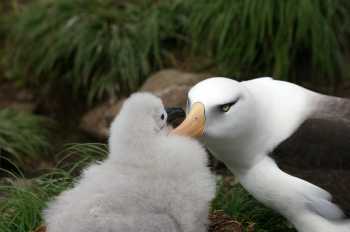Lisa Ann Sztukowski submitted a thesis to Plymouth University and the Université Pierre et Marie Curie in partial fulfilment for the degree of Doctor of Philosophy in August 2015, based on her research on the foraging ecology of the Campbell Albatross Thalassarche impavida.
The thesis English abstract follows:
“Most albatrosses are critically endangered, endangered or vulnerable due to the deleterious impact of fisheries, pollution, introduced species, habitat alteration, and climate change. Foraging behaviour influences many aspects of seabird biology, and a detailed understanding of foraging ecology is required to better predict the impacts of significant changes to the marine environment. Campbell Albatross (Thalassarche impavida) is a threatened endemic, confined to a small number of locations on Campbell Island, New Zealand and was recently split from the closely related Blackbrowed Albatross (T. melanophrys [=melanophris]). We currently lack much basic information on the foraging behaviour of this species, hindering our ability to understand how change may have occurred in the past and make predictions about it’s [sic] long-term future. First, I used GPS loggers and stable isotope analysis of blood to investigate how distribution and foraging effort (distance travelled and duration) varied with sex and breeding stage. I found that Campbell Albatrosses are sexually dimorphic and showed sex-specific foraging behaviour and habitat use – although this varied by stage of reproduction. Because males and females may be vulnerable to different threats, such as interactions with fisheries, I compared the spatial overlap and high resolution spatio-temporal overlaps between fisheries vessels and albatrosses within New Zealand’s Exclusive Economic Zone (EEZ). Albatrosses utilised 32% of the EEZ, however they overlapped with fisheries vessels in only 0.20% of the area. Previous research has demonstrated that the influence of fisheries vessels goes beyond the immediate location of the boat itself. Campbell Albatross have low levels of spatio-temporal overlap with fisheries – with males overlapping more than females. More generally, my results indicate that adding data on fine scale interactions will improve fisheries risk assessments, and provide information needed for the conservation and management of the Campbell Albatross. A key development in recent ecological research has been a greater appreciation that inter-individual variation in foraging behaviour can have profound population-level consequences. Accordingly I tested for individual differences in foraging behaviour in Campbell Albatrosses. The majority of individuals demonstrated both annual and interannual individual consistency in foraging locations, and the degree of specialisation was influenced by both sex and year. Consistent terminal latitude and longitude of foraging trips indicated high foraging area fidelity with a degree of flexibility in the fine-scale location. During brooding, females used the Campbell Plateau and showed more consistent behaviours than males, which tended to forage in the Southern Ocean. This adds to a growing body of evidence of individual foraging specialisation among seabirds in general and albatrosses in particular and reveals marked inter-individual differences in vulnerability to threats. In light of the evidence of individual foraging specialisations in the Campbell albatross, I also preformed [sic] a literature review of individual foraging specialisations across all seabirds. I found studies examining foraging specialisation for 35 species, with 28 (80%) providing evidence of consistent inter-individual differences (i.e. specialisation). Current studies suggest that specialisation is influenced by environmental variability vii and resource predictability, however, with limited data in tropical regions, more studies are needed to test these links. In summary, my thesis has provided new information on Campbell Albatross foraging ecology. Sex specific variations in behaviour and habitat use may influence conservation and management strategies. I have been able to contextualise the consistent individual differences in foraging distribution described for this species in light of global patterns of individual foraging specialisation in seabirds and highlight future areas of research.”

A Campell Albatross grooms its chick; photograph by David Evans
Reference:
Sztukowski, L.A. 2016. Foraging Ecology of the Campbell Albatross: Individual Specialisation and Fishery Interactions. PhD thesis, School of Marine Science and Engineering Marine Biology & Ecology Research Centre. 163 pp.
John Cooper, ACAP Information Officer, 09 September 2016

 English
English  Français
Français  Español
Español